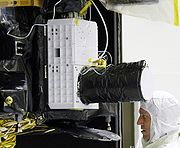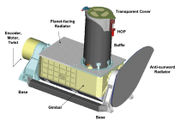
CRISM
Encyclopedia

Mars Reconnaissance Orbiter
Mars Reconnaissance Orbiter is a NASA multipurpose spacecraft designed to conduct reconnaissance and Exploration of Mars from orbit...
searching for mineralogic indications of past water on Mars
Mars
Mars is the fourth planet from the Sun in the Solar System. The planet is named after the Roman god of war, Mars. It is often described as the "Red Planet", as the iron oxide prevalent on its surface gives it a reddish appearance...
. The CRISM instrument team comprises scientists from over ten universities and led by principal investigator
Principal investigator
A principal investigator is the lead scientist or engineer for a particular well-defined science project, such as a laboratory study or clinical trial....
Scott Murchie. CRISM was designed, built, and tested by the Johns Hopkins University
Johns Hopkins University
The Johns Hopkins University, commonly referred to as Johns Hopkins, JHU, or simply Hopkins, is a private research university based in Baltimore, Maryland, United States...
Applied Physics Laboratory
Applied Physics Laboratory
The Johns Hopkins University Applied Physics Laboratory , located in Howard County, Maryland near Laurel and Columbia, is a not-for-profit, university-affiliated research center employing 4,500 people. APL is primarily a defense contractor. It serves as a technical resource for the Department of...
.
Objectives
CRISM is being used to identify locations on Mars that may have hosted waterWater
Water is a chemical substance with the chemical formula H2O. A water molecule contains one oxygen and two hydrogen atoms connected by covalent bonds. Water is a liquid at ambient conditions, but it often co-exists on Earth with its solid state, ice, and gaseous state . Water also exists in a...
, a chemical considered important in the search for past or present extraterrestrial life
Extraterrestrial life
Extraterrestrial life is defined as life that does not originate from Earth...
. In order to do this, CRISM is mapping the presence of minerals and chemicals that may indicate past interaction with water - low-temperature or hydrothermal. These materials include iron
Iron
Iron is a chemical element with the symbol Fe and atomic number 26. It is a metal in the first transition series. It is the most common element forming the planet Earth as a whole, forming much of Earth's outer and inner core. It is the fourth most common element in the Earth's crust...
and oxide
Oxide
An oxide is a chemical compound that contains at least one oxygen atom in its chemical formula. Metal oxides typically contain an anion of oxygen in the oxidation state of −2....
s, which can be chemically altered by water, and phyllosilicates and carbonate
Carbonate
In chemistry, a carbonate is a salt of carbonic acid, characterized by the presence of the carbonate ion, . The name may also mean an ester of carbonic acid, an organic compound containing the carbonate group C2....
s, which form in the presence of water. All of these materials have characteristic patterns in their visible-infrared energy and are readily seen by CRISM. In addition, CRISM is monitoring ice and dust particulates in the Martian atmosphere
Atmosphere of Mars
The atmosphere of Mars is relatively thin and is composed mostly of carbon dioxide . There has been interest in studying its composition since the detection of trace amounts of methane, which may indicate the presence of life on Mars, but may also be produced by a geochemical process, volcanic or...
to learn more about its climate and seasons.
Investigation description
CRISM measures visibleLight
Light or visible light is electromagnetic radiation that is visible to the human eye, and is responsible for the sense of sight. Visible light has wavelength in a range from about 380 nanometres to about 740 nm, with a frequency range of about 405 THz to 790 THz...
and infrared
Infrared
Infrared light is electromagnetic radiation with a wavelength longer than that of visible light, measured from the nominal edge of visible red light at 0.74 micrometres , and extending conventionally to 300 µm...
electromagnetic radiation
Electromagnetic radiation
Electromagnetic radiation is a form of energy that exhibits wave-like behavior as it travels through space...
from 370 to 3920 nanometers in 6.55 nanometer increments. The instrument has two modes, a multispectral untargeted mode and a hyperspectral targeted mode. In the untargeted mode, CRISM reconnoiters Mars, recording approximately 50 of its 544 measurable wavelengths at a resolution of 100 to 200 meters per pixel. In this mode CRISM will map half of Mars within a few months after aerobraking and most of the planet after one year. The objective of this mode is to identify new scientifically interesting locations that could be further investigated. In targeted mode, the spectrometer measures energy in all 544 wavelengths. When the MRO spacecraft is at an altitude of 300 km, CRISM detects a narrow but long strip on the Martian surface about 18 meters across and 10,800 meters long. The instrument sweeps this strip across the surface as MRO orbits Mars to image the surface.
Instrument design

Celsius
Celsius is a scale and unit of measurement for temperature. It is named after the Swedish astronomer Anders Celsius , who developed a similar temperature scale two years before his death...
(–280° Fahrenheit
Fahrenheit
Fahrenheit is the temperature scale proposed in 1724 by, and named after, the German physicist Daniel Gabriel Fahrenheit . Within this scale, the freezing of water into ice is defined at 32 degrees, while the boiling point of water is defined to be 212 degrees...
) by a radiator plate and three cryogenic coolers. While in targeted mode, the instrument gimbal
Gimbal
A gimbal is a pivoted support that allows the rotation of an object about a single axis. A set of two gimbals, one mounted on the other with pivot axes orthogonal, may be used to allow an object mounted on the innermost gimbal to remain immobile regardless of the motion of its support...
s in order to continue pointing at one area even though the MRO spacecraft is moving. The extra time collecting data over a targeted area increases the signal to noise ratio as well as the spatial and spectral resolution of the image. This scanning ability also allows the instrument to perform emission phase functions, viewing the same surface through variable amounts of atmosphere, which can be used to determine atmospheric properties. The Data Processing Unit (DPU) of CRISM performs in-flight data processing including compressing the data before transmission.
External links
- CRISM official website
- Browse Map of Images from JHUAPLApplied Physics LaboratoryThe Johns Hopkins University Applied Physics Laboratory , located in Howard County, Maryland near Laurel and Columbia, is a not-for-profit, university-affiliated research center employing 4,500 people. APL is primarily a defense contractor. It serves as a technical resource for the Department of...
.

